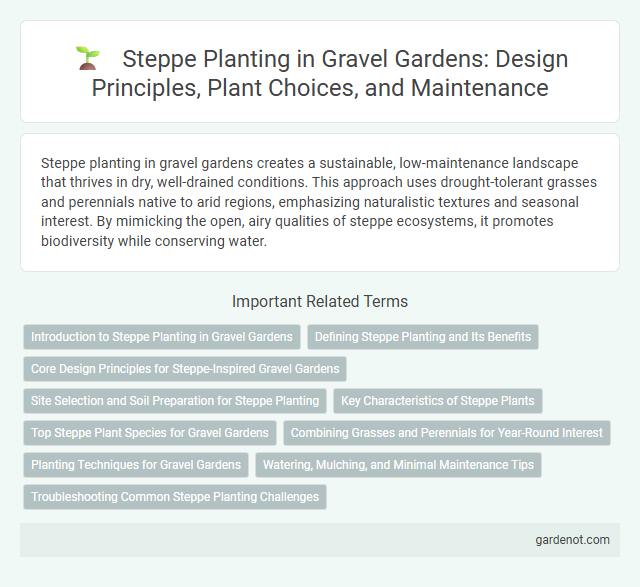Steppe planting in gravel gardens creates a sustainable, low-maintenance landscape that thrives in dry, well-drained conditions. This approach uses drought-tolerant grasses and perennials native to arid regions, emphasizing naturalistic textures and seasonal interest. By mimicking the open, airy qualities of steppe ecosystems, it promotes biodiversity while conserving water.
Introduction to Steppe Planting in Gravel Gardens
Steppe planting in gravel gardens utilizes drought-tolerant grasses and perennials native to semi-arid regions, creating a sustainable and low-maintenance landscape. Species such as Stipa tenuissima, Festuca glauca, and Salvia nemorosa thrive in well-drained gravel substrates, enhancing biodiversity while requiring minimal irrigation. This planting style promotes resilience to heat and water scarcity, making it ideal for xeriscaping and environmentally conscious garden designs.
Defining Steppe Planting and Its Benefits
Steppe planting involves using drought-tolerant grasses and perennials characteristic of temperate grasslands, creating a low-maintenance, water-efficient garden ideal for gravel landscapes. This approach enhances biodiversity by attracting pollinators and supports soil health through deep-rooted native species adapted to dry, nutrient-poor conditions. Incorporating steppe planting in gravel gardens reduces irrigation needs while delivering naturalistic aesthetics and resilience against harsh climates.
Core Design Principles for Steppe-Inspired Gravel Gardens
Steppe planting in gravel gardens emphasizes drought-tolerant species such as Stipa tenuissima, Artemisia, and Eryngium, which thrive in well-drained, nutrient-poor soils. Core design principles include layering plants with varying heights and textures to mimic natural grassland biodiversity while ensuring optimal sunlight exposure and water efficiency. Integrating native steppe grasses and perennials enhances sustainability and supports local wildlife, creating a resilient, low-maintenance landscape.
Site Selection and Soil Preparation for Steppe Planting
Site selection for steppe planting in a gravel garden requires well-drained, sunny locations with minimal soil fertility to mimic native steppe conditions. Soil preparation involves removing topsoil to reduce nutrient levels and incorporating coarse sand or gravel to improve drainage and prevent waterlogging. Establishing plants in these well-structured, low-nutrient soils supports drought-tolerant steppe species like Stipa and Salvia, ensuring sustainable growth.
Key Characteristics of Steppe Plants
Steppe plants are characterized by their drought tolerance, deep root systems, and ability to thrive in well-drained, nutrient-poor soils typical of gravel gardens. These plants often exhibit narrow leaves or fine textures that reduce water loss while enduring intense sunlight and temperature fluctuations. Their resilience and low maintenance requirements make them ideal choices for sustainable, xeriscape gravel garden designs.
Top Steppe Plant Species for Gravel Gardens
Top steppe plant species for gravel gardens include Stipa tenuissima, Festuca glauca, and Salvia nemorosa, which thrive in well-drained, nutrient-poor soils typical of gravel environments. These drought-tolerant grasses and perennials enhance texture and movement while optimizing water efficiency in xeriscaping designs. Incorporating native steppe species such as Artemisia and Echinops further supports biodiversity and resilience in sustainable gravel garden landscapes.
Combining Grasses and Perennials for Year-Round Interest
Steppe planting in gravel gardens thrives by combining drought-tolerant grasses like Festuca glauca and Stipa tenuissima with perennials such as Echinacea purpurea and Salvia nemorosa for vibrant year-round interest. This blend enhances texture and movement in the landscape while supporting biodiversity and reducing water consumption. Selecting species adapted to well-drained, low-nutrient soils ensures resilience and low-maintenance beauty throughout all seasons.
Planting Techniques for Gravel Gardens
Steppe planting in gravel gardens utilizes drought-tolerant grasses and perennials that thrive in well-drained, nutrient-poor soils, reducing water demand and maintenance. Techniques such as layering plants by height and texture create naturalistic, flowing compositions that mimic native steppe ecosystems. Incorporating deep root systems enhances soil stability and supports biodiversity, optimizing the gravel garden's ecological function.
Watering, Mulching, and Minimal Maintenance Tips
Steppe planting in a gravel garden thrives with deep, infrequent watering to encourage drought-resistant root systems and conserve water. Applying a layer of organic mulch like shredded bark reduces soil evaporation, suppresses weeds, and maintains consistent soil temperatures. Minimal maintenance involves occasional pruning of drought-tolerant grasses and perennials to promote healthy growth without disrupting the low-water ecosystem.
Troubleshooting Common Steppe Planting Challenges
Steppe planting in gravel gardens often faces challenges such as poor soil drainage, excessive heat exposure, and invasive species competition. Ensuring proper soil amendment with organic matter improves water retention and root development, while choosing drought-tolerant native plants like Stipa tenuissima and Artemisia minimizes stress during hot, dry periods. Regular monitoring for invasive weeds and timely mulching control competition, promoting healthy growth in steppe environments.
Steppe planting Infographic

 gardenot.com
gardenot.com